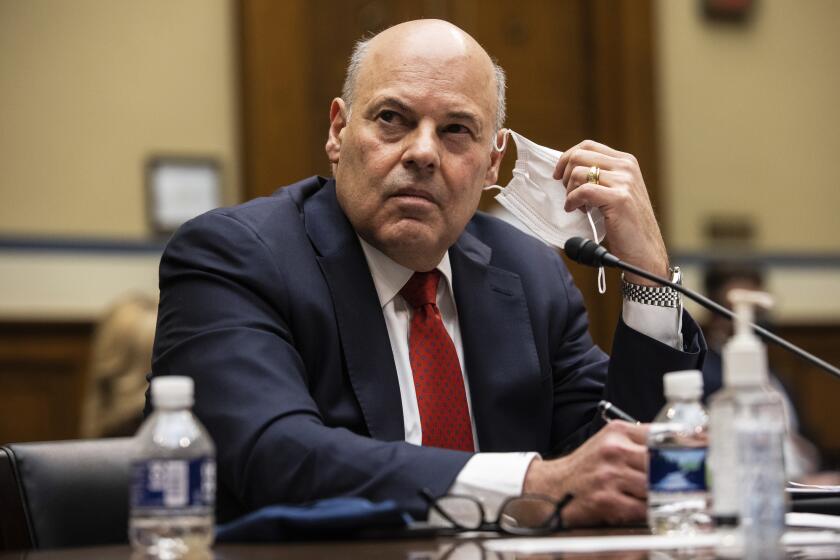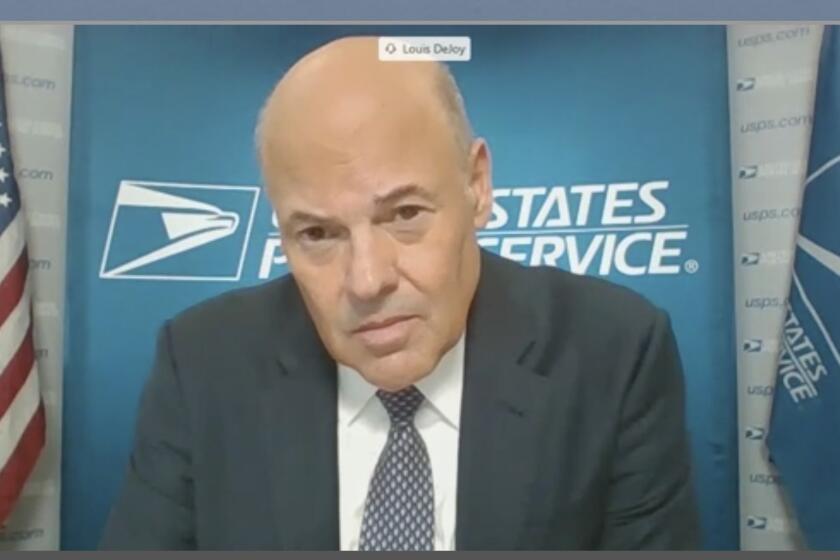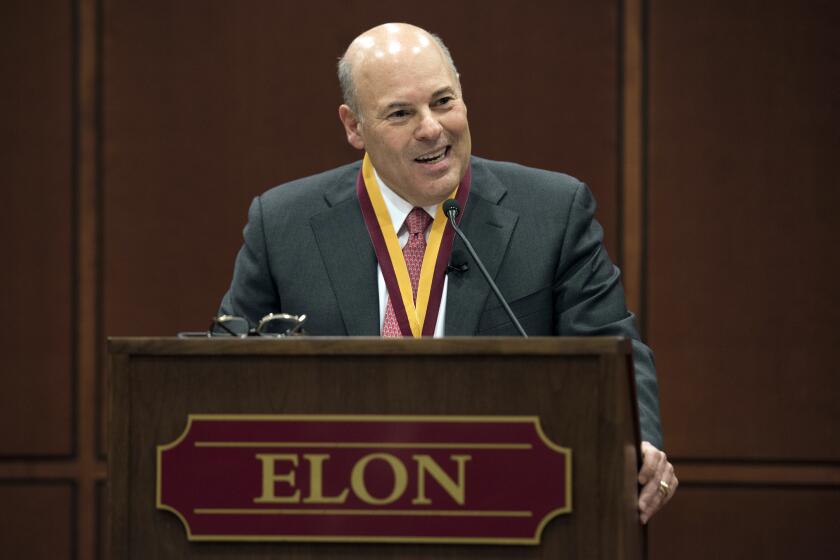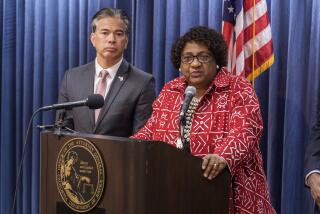Column: Will the Postal Service be up to the task of delivering ballots on time? Election officials are worried

- Share via
The U.S. Postal Service keeps promising that things are getting better — more efficient operations, more reliable mail delivery, improved finances, a more climate-friendly truck fleet and so on. To outside observers, things are certainly changing, for the worse.
Among the service’s critics are state election officials coast to coast, who expressed concerns earlier this month about its “ability to deliver election mail in a timely and accurate manner.” Despite numerous meetings with USPS headquarters and regional staff, “we have not seen improvement or concerted efforts to remediate our concerns.”
The officials made their point in a letter to Postmaster General Louis DeJoy, which points to another question that many people have about the USPS: Why is DeJoy still in his job?
Operational changes [at the USPS]...pose a risk of individual ballots not being counted.
— USPS Office of the Inspector General
That question is pertinent because DeJoy’s performance has been heavily criticized throughout his tenure. Indeed, even his appointment in June 2020 provoked suspicions about political favoritism — he’s a logistics executive with no postal experience — DeJoy had been a major fundraiser for then-President Trump.
DeJoy implemented a plan to shore up the service’s finances by limiting overtime, dismantling high-speed sorting machines and ordering postal vehicles to start on their rounds before they had been fully loaded, among other changes.
Get the latest from Michael Hiltzik
Commentary on economics and more from a Pulitzer Prize winner.
You may occasionally receive promotional content from the Los Angeles Times.
Postal operations cratered. The decline in on-time performance was so severe that many in Congress and in the nation at large speculated that he had been put in place deliberately to hamstring the delivery of mailed ballots in the 2020 election.
In the event, the service performed adequately, at least on a national scale.
“The agency successfully ensured that over 97% of ballots were delivered within five days throughout the final weeks of the election and far fewer ballots were misplaced or delayed than what many feared,” according to the Stanford-MIT Healthy Elections Project.
There were regional breakdowns, however — in Detroit, the on-time delivery rate fell below 80% starting in late October, and similar delays occurred in parts of Colorado, Wyoming and Pennsylvania. On Election Day, delivery records were missing for some 300,000 ballots, including tens of thousands in Pennsylvania and Florida.
At that time, the USPS had to grapple with a surge in mail ballots, as the COVID-19 pandemic discouraged voters from physically visiting ballot places. This year, it may face an even greater tsunami of mail ballots, for voting by mail has become more widespread and the presidential election may generate a higher turnout than usual.
Notwithstanding the service’s claims to have created and implemented special protocols for handling election-related mail, the state officials say that over the last year they have seen voter mail “being marked undeliverable at higher than usual rates, even in cases where a voter is known not to have moved.” Ballots have been delivered as much as 10 days after they’re postmarked, which means they may not be counted.
The basic flaw in discussions about the Postal Service is the idea that it’s a business. It’s anything but.
These snafus are so common and widespread, the officials stated, that they were clearly “not one-off mistakes or a problem with specific facilities.” Instead, they show “a pervasive lack of understanding and enforcement of USPS policies among its employees.”
Similar concerns about the service’s readiness for the coming election were aired in July by the USPS inspector general, who stated that the service’s “operational changes ... pose a risk of individual ballots not being counted.”
It’s proper to recognize that the USPS faces some unique issues as a government agency. The Constitution gives Congress the sole authority to establish a postal system, but in 1970 Congress removed the postmaster general from the Cabinet and subjected the post office to a quasi-privatization. Then, in 2006, the lawmakers saddled the USPS with a unique obligation to pre-fund its retiree health benefits, at a cost of up to $6 billion a year. (The obligation was rescinded in 2022.)
The notion has persisted for years that the USPS should be “run like a business,” paying its way on a profit-and-loss basis. But that’s a formula for exacerbating its problems, which included a secular decline in first-class mail and the rise of competitors such as FedEx and UPS in parcel shipping.
Of course it’s not a business, but a public service aiming to tie the entire nation together; no one should expect the Postal Service to fulfill its responsibilities at a profit any more than we expect the national highway system or K-12 schools to do so. Under DeJoy, first-class postage rates have been raised seven times in four years, from 55 cents in January 2021 to 73 cents as of July this year.
Another problem with USPS management is that the president doesn’t have the power to fire the postmaster general. That authority rests with the nine-member USPS Board of Governors, who must be confirmed by the Senate. No more than five can represent any one party. Republicans have consistently interfered with appointments to the board by Presidents Obama and Biden; nominees for two vacancies are still unconfirmed.
Louis DeJoy hasn’t been fired yet as postmaster general. Why the delay?
But that has made it almost impossible (so far) to dislodge DeJoy, who has presided over a steady deterioration in the service’s performance and reputation, despite his habit of responding to criticism with arrogance and truculence.
DeJoy’s resistance to taking advice from lawmakers only exacerbated doubts about the maneuvering that put him in his job. As I reported at the time, his name came to the Board of Governors independently of a headhunting firm that the board had commissioned to find candidates for postmaster general. He wasn’t on the headhunters’ list. Instead he was introduced by board member John M. Barger, a Southern California investment executive who was supervising the postmaster search.
His appointment prompted the resignation of David M. Williams, the board’s vice chairman, who later testified to a congressional caucus that the hiring process was rigged for DeJoy, who was coached during the interview process, and that no background check was conducted before his hiring.
The continuing decline in the Postal Service ‘s stature has lately been countered by what appears to be a concerted effort to burnish DeJoy’s image. He spoke up for himself in July with an op-ed in the Washington Post, in which he appealed for patience in his more than three-year effort to “improve our efficiency and accuracy, reduce costs, improve service, grow revenue and create appropriate work environments for our employees.”
DeJoy observed that “by September 2023, 98 percent of Americans received their mail and packages within three days” and asserted that, “although we have slipped recently because of difficulties in overcoming our degraded operating conditions while opening new facilities ... we will soon be back to a performance level that can make the nation proud.”
Things seem to be moving in reverse, however. The service’s most recent operational statistics, released Feb. 5, showed that 82.7% of first-class mail was delivered on time as defined by its “service standard,” which is to deliver all first-class letters within the continental U.S. within five days; moving the goalposts, the USPS had raised that standard from three days in 2022 because it deemed the former standard “unattainable.”
The new standard hasn’t fared much better. The inspector general reported that for the quarter ended June 30, only 72.5% of first-class mail given three to five days to reach its destination made it on time — a decrease of 13.7 percentage points from the same period last year.
“They get worse each year,” says Dave Lewis, president of the direct mail consultancy SnailWorks. On-time delivery of first-class letters has fallen to 82% this year, according to the firm’s nationwide tracking system.
Trump’s attack on the U.S. Postal Service goes beyond vandalism and undermines democracy.
“I’m not optimistic about how they’re going to perform in the fall,” Lewis told me, referring to a period when holiday season direct mail, election mail and ballots will combine into a triple threat for USPS personnel and equipment.
DeJoy’s 10-year USPS reform plan, dubbed “Delivering for America,” remains the target of brickbats from consumer advocates and others. “DeJoy’s 10-year plan would increase delivery times, slash tens of thousands of jobs through attrition, and cut operations at more than 200 post offices and sorting facilities — which could devastate rural and Indigenous communities,” the Revolving Door Project, an executive branch watchdog, asserted in July as a response to DeJoy’s op-ed.
In response to my request for a comment on the election officials’ letter, the USPS referred me to a response DeJoy made directly to the officials.
“I am personally fully committed to effective implementation of our longstanding processes and procedures designed to ensure that all ballot mail is delivered in a timely and secure manner,” he wrote. But he added that “as a common-sense measure,” voters should mail their ballots at least one week prior to their state’s deadline — a subtle signal that the USPS might run into snags getting mail across town from voters to their local ballot-counting location within its “attainable” five-day deadline.
Does DeJoy really understand the necessity of getting his arms around the election mail issue? Delivery problems in Georgia, a battleground state that has one of the worst on-time records in the nation, could have reverberations for the nation. Election mail returned as “undeliverable” could include polling-place information, address confirmation notices and ballots themselves.
The return could prompt the removal of a voter from the rolls, causing the “disenfranchisement of voters whose ballots are not delivered to them or to their election office,” and put “eligible voters on the path to having their voter registration record canceled.”
The USPS may have no more important task just now than getting every piece of election mail to every eligible voter. It doesn’t matter whether DeJoy’s management is incompetent, neglectful, sinister or merely not up to the task. There is no conceivable excuse for his not getting it right.
More to Read
Get the latest from Michael Hiltzik
Commentary on economics and more from a Pulitzer Prize winner.
You may occasionally receive promotional content from the Los Angeles Times.














